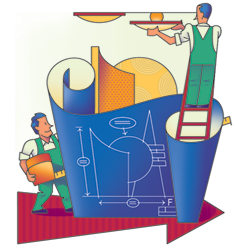|
Help!

FABRIC EXHIBITRY
 About 10 years ago, my company created several tensioned-fabric exhibits. Now, we're looking to add more, and larger, fabric booths to our arsenal. Is there anything new in the material world that I should know about before I make a purchase? About 10 years ago, my company created several tensioned-fabric exhibits. Now, we're looking to add more, and larger, fabric booths to our arsenal. Is there anything new in the material world that I should know about before I make a purchase?
 The fabric bandwagon started rumbling along 30 years ago, as exhibit manufacturers responded to the industry's demand for lightweight, easy-to-handle components that could also deliver a significant cost savings. Back then, tensioned-fabric components were used almost exclusively in small booths or banners and back-wall structures. Often, fabric wasn't really the focal point of the booth, but merely another medium – except that it was lighter and easier to handle than its traditional counterparts.
The fabric bandwagon started rumbling along 30 years ago, as exhibit manufacturers responded to the industry's demand for lightweight, easy-to-handle components that could also deliver a significant cost savings. Back then, tensioned-fabric components were used almost exclusively in small booths or banners and back-wall structures. Often, fabric wasn't really the focal point of the booth, but merely another medium – except that it was lighter and easier to handle than its traditional counterparts.
Today, however, tensioned-fabric exhibitry has evolved past straight shapes and small-component applications. Its lightweight, flexible framing can now create almost any shape imaginable. And rather than acting as a backdrop, fabric – particularly large-format printed fabric graphics – have become a focal point in exhibits. As such, fabric is being used to create enormous exhibits, and designers are regularly mixing and matching stiff, traditional materials with tensioned-fabric components.
Clearly, then, yesterday's fabric exhibit is a whole different animal than today's tensioned-fabric creations. Now, there are a lot more opportunities to incorporate fabric, and more options when doing so. But to make the most of this fabric evolution, you'll need a quick primer on some of the most recent advancements. Here, then, are six of the most important strides fabric exhibitry has made in the last 10 years.
Connections and Construction The tensioned-fabric industry has moved beyond nuts-and-bolts assembly methods and toward self-contained framing systems that interlock or snap together. Thus, new fabric constructions require fewer tools and labor hours to install and dismantle.
Along those lines, silicone-edged graphics, or SEGs, have revolutionized the manner in which fabrics interact with frames. In the past, most tensioned-fabric structures had a pillowcase design, as the fabric simply slid over the framing. Now, there's an even mix of pillowcase options and SEGs. With the latter, a silicone gasket is attached to the edges of the fabric, and those gaskets are then slid into grooves on a frame. Today's SEG applications create seamless single-panel walls, massive lightboxes, and wondrous shapes – all with clean, hidden corners and hardware.
High-Quality Graphics In addition to forming structural components, such as walls, ceiling elements, etc., contemporary fabrics can also be used as graphics-display mediums. Due to advancements in dye-sublimation printing, you can now print photo-quality images with top-of-the-line sharpness directly onto fabric. Thus, dramatic, high-res images can be printed on huge sections of fabric to create eye-catching graphics with the same positive properties – easy installation, light weight, low cost, etc. – as traditional fabric components.
Availability and Integration It used to be that you purchased either a traditional, hard-surface exhibit or a fabric structure; rarely did designers choose to mix and mingle the two options in a successful exhibit design. Today, however, traditional and fabric exhibitry are regularly used in tandem. Designers are becoming more adept at suggesting ways in which fabric can be used to add drama, messaging, structural components, and much more.
Organic Shapes Current framing systems allow designers to craft tensioned-fabric components in a seemingly endless variety of shapes. While earlier frames typically created a box-like form, now you can craft smooth, organic shapes, flowing curves, sweeping arches, etc. Plus, a properly stretched tensioned-fabric piece can create the illusion of a solid structure. By pairing these frame advancements with improvements in computer-aided patterning and manufacturing, you can also develop huge, complex structures.
Projection-Mapping Canvas While projection mapping has been around for a while, exhibitors are just now adopting this trendy new technology into their exhibit programs. And since fabric offers the versatility to create complex and interesting sculptures and shapes, it's a perfect projection-mapping canvas. Together, projection-mapping technology and fabric can add spectacular colors and dramatic movement, ultimately creating an emotional and memorable experience for booth visitors.
Ancillary Add-Ons Thirty years ago, fabric exhibitry comprised merely a frame and fabric, and nary a single add-on component. Today, however, fabric systems offer a plethora of functional and aesthetic accessories, including everything from lightboxes and shelving, to angled end panels and integrated monitors. In addition, sound-control and -blocking techniques can be integrated into the design so that fabric can be used to form walls for private conference rooms and meeting areas.
So while plenty of exhibitors hopped aboard the tensioned-fabric bandwagon over the last 30 years, advances in framing and graphics have led to even greater industry acceptance. And since designers and exhibit houses are more willing to work with and integrate fabric elements, tensioned-fabric components are no longer an "alternative" option for exhibits. In fact, their myriad benefits and recent improvements have made them a medium of choice for many exhibitors.
— Mel Marzan, marketing communications manager, Moss Inc., Chicago
|




 About 10 years ago, my company created several tensioned-fabric exhibits. Now, we're looking to add more, and larger, fabric booths to our arsenal. Is there anything new in the material world that I should know about before I make a purchase?
About 10 years ago, my company created several tensioned-fabric exhibits. Now, we're looking to add more, and larger, fabric booths to our arsenal. Is there anything new in the material world that I should know about before I make a purchase? The fabric bandwagon started rumbling along 30 years ago, as exhibit manufacturers responded to the industry's demand for lightweight, easy-to-handle components that could also deliver a significant cost savings. Back then, tensioned-fabric components were used almost exclusively in small booths or banners and back-wall structures. Often, fabric wasn't really the focal point of the booth, but merely another medium – except that it was lighter and easier to handle than its traditional counterparts.
The fabric bandwagon started rumbling along 30 years ago, as exhibit manufacturers responded to the industry's demand for lightweight, easy-to-handle components that could also deliver a significant cost savings. Back then, tensioned-fabric components were used almost exclusively in small booths or banners and back-wall structures. Often, fabric wasn't really the focal point of the booth, but merely another medium – except that it was lighter and easier to handle than its traditional counterparts. 


